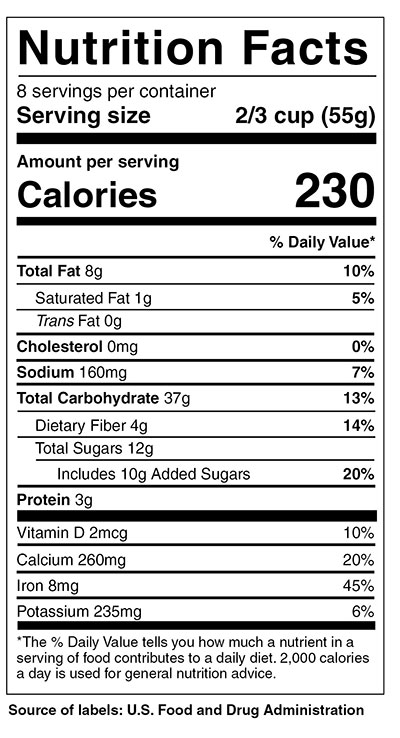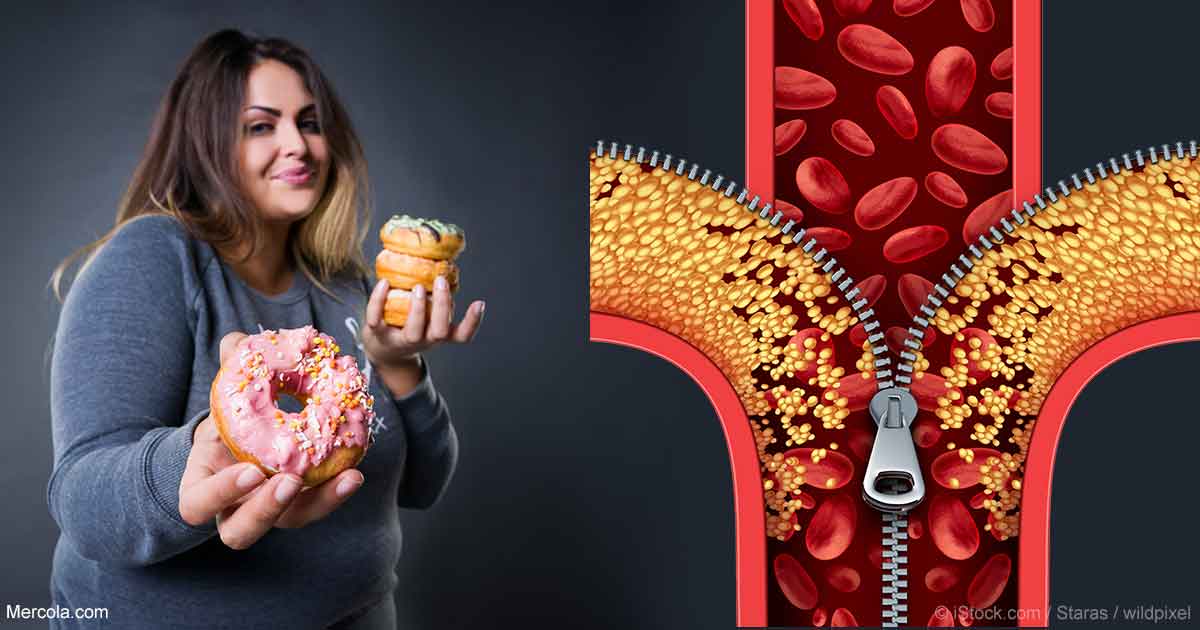45 how to read fats on food labels
How to Read Nutrition Labels: Fat Content, Carbs & What To ... - HighKey Nutrition labels are required to include total fat, saturated fat, and trans fat. The total amount of fat in the diet is a percentage of your calorie needs. The recommendation for the typical American diet is around 30%. For someone taking in 2,000 calories, this would mean around 70 grams of total fat per day. How to Read a Food Label - Well Guides - The New York Times Removing calories from fat. More recent studies have shown that it's the type of fat (trans fat and saturated fat vs. monounsaturated and polyunsaturated fats) ...
How to Read Food Labels : Food Network | Food Network The percent of the Daily Value that is listed on the upper portion of the food label is yet another way to gauge how much saturated fat and cholesterol are in the foods that you buy and eat. If a...
How to read fats on food labels
3 Ways to Read Nutrition Facts on Food Labels - wikiHow Read the fat content in a serving and check what types of fat are present. The next row on the label is fat, and it is accompanied by 2 different types of fat underneath the total number content. Fat helps provide cell development and stores energy in the body. Fat Content on Food Labels - Reading Between the Lines The Mayo Foundation continued, "Still, you may be able to tell if a product contains trans fat, even if it's not directly listed on the food label. Look for the words ' hydrogenated ' or 'partially hydrogenated' in the list of ingredients. These terms indicate that the product contains trans fat. Food Labels | CDC - Centers for Disease Control and Prevention All the numbers on this label are for a 2/3-cup serving. This package has 8 servings. If you eat the whole thing, you are eating 8 times the amount of calories, carbs, fat, etc., shown on the label. Total Carbohydrate shows you types of carbs in the food, including sugar and fiber. Choose foods with more fiber, vitamins, and minerals.
How to read fats on food labels. How to read food labels: MedlinePlus Medical Encyclopedia These fats are mostly found in snack foods and desserts. Many fast food restaurants use trans fats for frying. If a food has these fats, the amount will be listed on the label under total fat. They are measured in grams. Look for foods that have no trans fats or are low in them (1 gram or less). Sodium is the main ingredient of salt. How To Read Nutrition Labels - Mayo Clinic Diet 3. Check the % Daily Value. The % Daily Value (DV) tells you how much a nutrient in a serving of food contributes to a daily diet. 2,000 calories a day is used for general nutrition advice. Low is 5% or less. Aim for low in saturated fat, trans fat, cholesterol, sodium, and added sugars. High is 20% or more. Aim high in vitamins, minerals and ... Fats, sugar, carbs: How to read a food label (and seven ... - Good Food The "total carbohydrate content" of the food will actually include the sugars within this number and give you an idea of the amount of fuel a food contains. For example, if you consider that a slice of bread or a piece of fruit contains 15-20 grams of carbs per serve, then a food that contains 60-80 grams of carbs per serve is an energy-dense ... How to Read a Food Label & How to Find Unhealthy Hidden Ingredients If the food label has partially hydrogenated oil in it, it has trans fat. Foods that commonly contain partially hydrogenated oils are baked goods, fried foods, snacks and creamer and margarine (13). Avoid any products that list one of these ingredients " partially hydrogenated ," " fractionated ," " shortening " or " hydrogenated ".
How to Read Everything on the Nutrition Facts Label - Food Network If you want to figure out the grams of fat that it will take you to get about 30% of fat in your diet each day do the following: Estimate your total calories for the day. Let's say that number is... Interpreting Total Fat and Types of Fat on Food Labels - Nina Cherie ... Now, at the end of the day, since all high-fat foods tend to drive up calorie counts, it's typically recommended that you limit your intake of total fat to 25-35% of your daily calories. Of this amount, saturated fats and trans fats should comprise less than 7-10% and no more than 1%, respectively. At the very least, following these ... How to Read Nutrition Facts Labels the Right Way - GoodRx Healthy fats can be a bit harder to find on a nutrition label. They are not required to be listed under "total fat," although some food manufacturers may voluntarily do so. Even if a product does not list these fats, you can identify them by becoming familiar with the sources of each type of fat. Sources of monounsaturated fats include: Nuts Seeds How to Read Food Labels Like a Nutritionist | HUM Nutrition Blog Just check the nutrition content of a pasta sauce or soup.) Nelson says the daily general sodium recommendation for adults is 3,400 milligrams (less than two teaspoons!). "To help manage your sodium better, avoid single-serving foods offering more than 300 milligrams of sodium. For meals, aim for only 500 to 700 milligrams of sodium," she ...
Easy Guide to Understanding Food Labels When You Have High ... - MyDoc Ideally, best to get 0 grams of this per day. Keep in mind that manufacturers can list their products as 0 grams if it has less than 0.5 grams of trans fat per serving. This means that your food may contain trans-fat even if the food label says 0 gram. Therefore it's important to check the ingredient list (more on this later). How to Understand and Use the Nutrition Facts Label | FDA Nutrients to get less of: Saturated Fat, Sodium, and Added Sugars. Saturated fat, sodium, and added sugars are nutrients listed on the label that may be associated with adverse health effects - and... This Is How to Read a Nutrition Facts Label on the Keto Diet The Basics of Reading Food Labels: How to Read a Label in 5 Steps (For Any Diet) To make healthy food choices, stick to these five steps. Step #1: Check the Serving Size Always start by looking at its serving size. This will ensure that you're calculating nutrition based on the amount of food you're actually consuming. PDF How to Read the Food Label - University of California, Santa Cruz The percentages help you find foods high in good nutrients and low in nutrients you want to avoid. If the value is 20% or more, it's considered high. If it's 5% or less, it's low. Total fat. This tells you how much fat is in one serving. A . low-fat food has 3 grams (g) or less of total fat per serving. Saturated fat and trans fat
How to Read Food Labels for Fats and Oils - Labels Unwrapped Reading the ingredient lists on products will reveal the source of the fat. For oils and fats ingredient lists, fats and oils are referred to by their common names (e.g., "beef fat," "cottonseed oil"). Like other ingredient lists, the types of fat and oils used should be listed by predominance.
How To Read Food and Beverage Labels - National Institute on Aging How to read the Nutrition Facts label The U.S. Food and Drug Administration (FDA) requires a Nutrition Facts label on most packaged foods and beverages. At the top of the Nutrition Facts label, you will find the total number of servings in the container and the food or beverage's serving size.

STARZ Cafeteria: Understanding Fats : Saturated Fats (Bad Fats) VS Unsaturated Fats (Good Fats)
Reading and Understanding Food Labels and Nutrition Info Divide the calories from fat by the total calories. Keep in mind not every food you eat needs to contain less than 30 percent of the calories from fat. Some ...
How to Read Food Labels Without Being Tricked - Healthline Still, processed foods that are labeled low-carb are usually still processed junk foods, similar to processed low-fat foods. Made with whole grains. The product may contain very little whole ...

How to read food labels – CNM Ireland – College of Naturopathic Medicine – A leading provider of ...
How to Read Food Labels + Nutrition Facts • Healthy.Happy.Smart. Detailed Guide on how to Read Food Labels This involves dissecting the information on the food label to know the nutritional content of the food. This information contains all of the following: serving size servings per container/package calories Fats, saturated fats, trans fats sodium protein carbohydrates dietary fiber sugars
Food Labels: Fat & Cholesterol | Home & Garden Information Center The Nutrition Facts label shows you how much fat is in a product, even if the fat is hidden as an ingredient. The serving size and the nutrients listed on this label are consistent, which makes it easy to compare similar products without any calculations. % Daily Values (% DVs) are listed in a column on the "Nutrition Facts" label.
Reading Food Labels (for Parents) - Nemours KidsHealth Saturated fats should account for less than 10% of the calories that kids eat each day. Trans fat should be as low as possible (less than 1% of total calories).
Understanding Food Labels | The Nutrition Source | Harvard T.H. Chan ... These statements describe the nutrients in a food beyond what is listed on the Nutrition Facts label, intended to showcase a health benefit of the food. An example is "Contains 100% Vitamin C.". Most terms like "low sodium," "high fiber," "reduced fat," and "good source of" are regulated by the FDA, and the nutrient amounts ...





Post a Comment for "45 how to read fats on food labels"